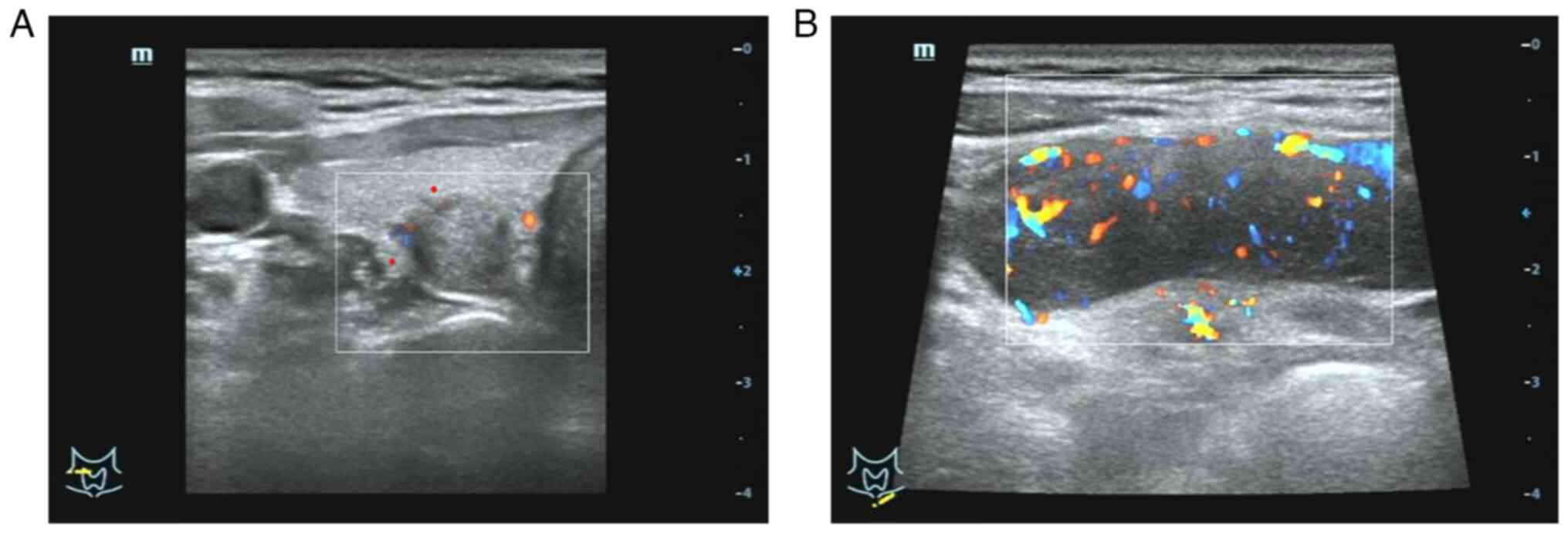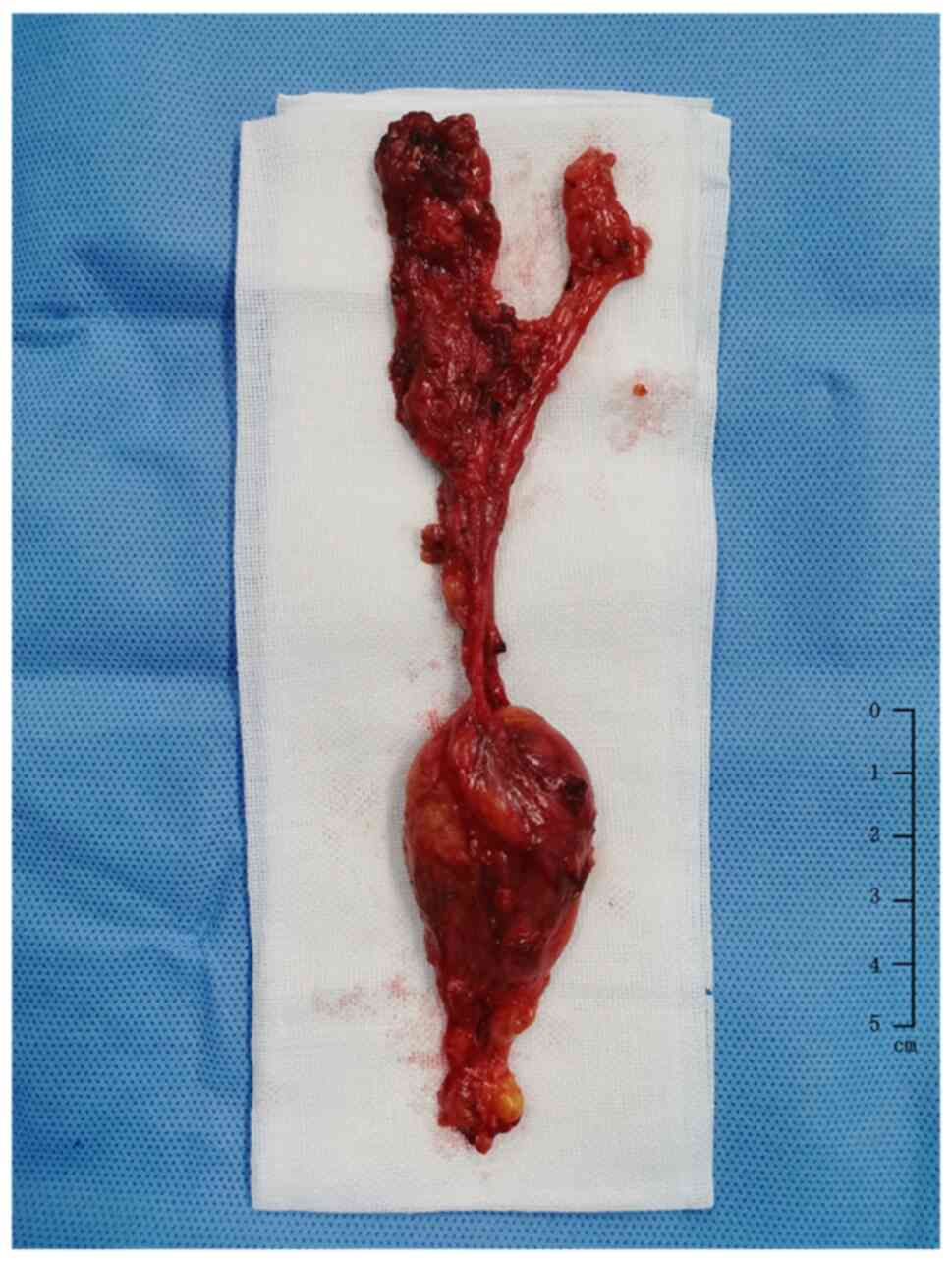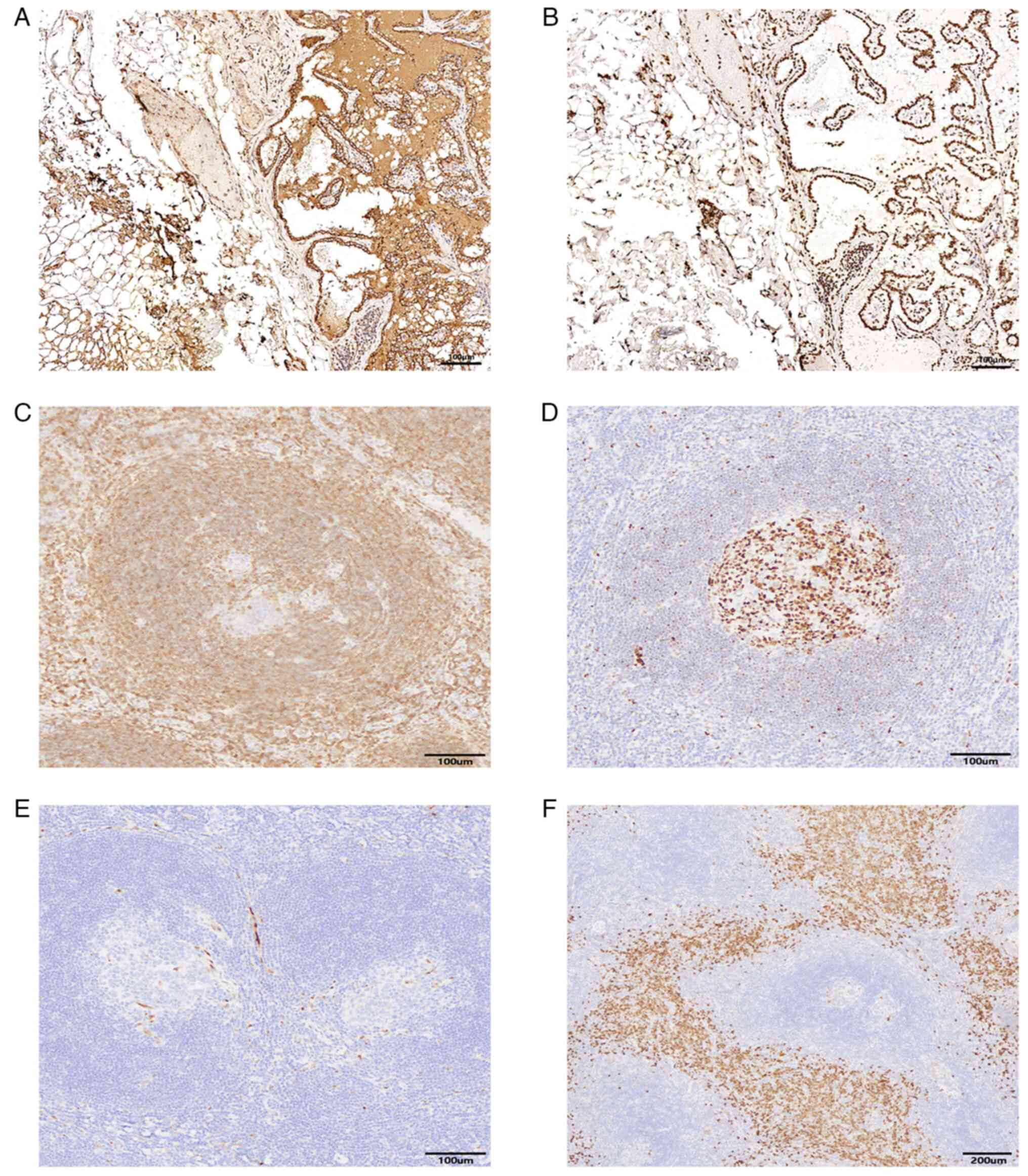|
1
|
Kitahara CM and Schneider AB: Epidemiology
of thyroid cancer. Cancer Epidemiol Biomarkers Prev. 31:1284–1297.
2022. View Article : Google Scholar : PubMed/NCBI
|
|
2
|
Pizzato M, Li M, Vignat J, Laversanne M,
Singh D, La Vecchia C and Vaccarella S: The epidemiological
landscape of thyroid cancer worldwide: GLOBOCAN estimates for
incidence and mortality rates in 2020. Lancet Diabetes Endocrinol.
10:264–272. 2022. View Article : Google Scholar : PubMed/NCBI
|
|
3
|
Castleman B and Towne VW: Case records of
the massachusetts general hospital: Case No. 40231. N Engl J Med.
250:1001–1005. 1954.PubMed/NCBI
|
|
4
|
Talat N, Belgaumkar AP and Schulte KM:
Surgery in Castleman's disease: A systematic review of 404
published cases. Ann Surg. 255:677–684. 2012. View Article : Google Scholar : PubMed/NCBI
|
|
5
|
Carbone A, Borok M, Damania B, Gloghini A,
Polizzotto MN, Jayanthan RK, Fajgenbaum DC and Bower M: Castleman
disease. Nat Rev Dis Primers. 7:842021. View Article : Google Scholar : PubMed/NCBI
|
|
6
|
Oksenhendler E, Boutboul D, Fajgenbaum D,
Mirouse A, Fieschi C, Malphettes M, Vercellino L, Meignin V, Gérard
L and Galicier L: The full spectrum of Castleman disease: 273
Patients studied over 20 years. Br J Haematol. 180:206–216. 2018.
View Article : Google Scholar : PubMed/NCBI
|
|
7
|
Keller AR, Hochholzer L and Castleman B:
Hyaline-vascular and plasma-cell types of giant lymph node
hyperplasia of the mediastinum and other locations. Cancer.
29:670–683. 1972. View Article : Google Scholar : PubMed/NCBI
|
|
8
|
So YK, Kim MJ, Kim S and Son YI: Lateral
lymph node metastasis in papillary thyroid carcinoma: A systematic
review and meta-analysis for prevalence, risk factors, and
location. Int J Surg. 50:94–103. 2018. View Article : Google Scholar : PubMed/NCBI
|
|
9
|
Strollo DC, Rosado de Christenson ML and
Jett JR: Primary mediastinal tumors. Part 1: Tumors of the anterior
mediastinum. Chest. 112:511–522. 1997. View Article : Google Scholar : PubMed/NCBI
|
|
10
|
Cibas ES and Ali SZ: The 2017 Bethesda
system for reporting thyroid cytopathology. Thyroid. 27:1341–1346.
2017. View Article : Google Scholar : PubMed/NCBI
|
|
11
|
Filetti S, Durante C, Hartl D, Leboulleux
S, Locati LD, Newbold K, Papotti MG and Berruti A; ESMO Guidelines
Committee. Electronic address, : simpleclinicalguideclinicalguidelines@esmo.org:
Thyroid cancer: ESMO clinical practice guidelines for diagnosis,
treatment and follow-up†. Ann Oncol. 30:1856–1883. 2019. View Article : Google Scholar : PubMed/NCBI
|
|
12
|
Simpson D: Epidemiology of castleman
disease. Hematol Oncol Clin North Am. 32:1–10. 2018. View Article : Google Scholar : PubMed/NCBI
|
|
13
|
Wong RSM: Unicentric castleman disease.
Hematol Oncol Clin North Am. 32:65–73. 2018. View Article : Google Scholar : PubMed/NCBI
|
|
14
|
Wang XQ, Zhong NN, Sun Q, Yan SC, Xu GC,
Wang YG, Peng LW, Liu B and Bu LL: Comprehensive analysis of 65
patients with Castleman disease in a single center in China. Sci
Rep. 12:86942022. View Article : Google Scholar : PubMed/NCBI
|
|
15
|
Haap M, Wiefels J, Horger M, Hoyer A and
Müssig K: Clinical, laboratory and imaging findings in Castleman's
disease-The subtype decides. Blood Rev. 32:225–234. 2018.
View Article : Google Scholar : PubMed/NCBI
|
|
16
|
Akram W, Degliuomini J, Wallack MK, Huang
S, Okechukwu E and Eric T: Unicentric Castleman's disease
masquerading as a carcinoid tumor of the small intestine. Am Surg.
82:e287–e289. 2016. View Article : Google Scholar : PubMed/NCBI
|
|
17
|
Kang D, Lee J, Lee H and Baek S:
Unicentric Castleman's disease in the orbit: A case report. Indian
J Ophthalmol. 63:555–557. 2015. View Article : Google Scholar : PubMed/NCBI
|
|
18
|
Tsai MH, Pai HH, Yen PT, Huang TS and Ho
YS: Nasopharyngeal Castleman's disease. J Formos Med Assoc.
95:877–880. 1996.PubMed/NCBI
|
|
19
|
Liu Y, Chen G, Qiu X, Xu S, Wu Y, Liu R,
Zhou Q and Chen J: Intrapulmonary unicentric Castleman disease
mimicking peripheral pulmonary malignancy. Thorac Cancer.
5:576–580. 2014. View Article : Google Scholar : PubMed/NCBI
|
|
20
|
Zhang E, Li Y and Lang N: Case report:
Castleman's disease involving the renal sinus resembling renal cell
carcinoma. Front Surg. 9:10013502022. View Article : Google Scholar : PubMed/NCBI
|
|
21
|
Boutboul D, Fadlallah J, Chawki S, Fieschi
C, Malphettes M, Dossier A, Gérard L, Mordant P, Meignin V,
Oksenhendler E and Galicier L: Treatment and outcome of unicentric
Castleman disease: A retrospective analysis of 71 cases. Br J
Haematol. 186:269–273. 2019. View Article : Google Scholar : PubMed/NCBI
|
|
22
|
Gündüz E, Kırkızlar HO, Ümit EG, Karaman
Gülsaran S, Özkocaman V, Özkalemkaş F, Candar Ö, Elverdi T,
Küçükyurt S, Paydaş S, et al: Castleman disease: A multicenter case
series from turkey. Turk J Haematol. 39:130–135. 2022.PubMed/NCBI
|
|
23
|
van Rhee F, Oksenhendler E, Srkalovic G,
Voorhees P, Lim M, Dispenzieri A, Ide M, Parente S, Schey S,
Streetly M, et al: International evidence-based consensus
diagnostic and treatment guidelines for unicentric Castleman
disease. Blood Adv. 4:6039–6050. 2020. View Article : Google Scholar : PubMed/NCBI
|
|
24
|
Fajgenbaum DC, Uldrick TS, Bagg A, Frank
D, Wu D, Srkalovic G, Simpson D, Liu AY, Menke D, Chandrakasan S,
et al: International, evidence-based consensus diagnostic criteria
for HHV-8-negative/idiopathic multicentric Castleman disease.
Blood. 129:1646–1657. 2017. View Article : Google Scholar : PubMed/NCBI
|
|
25
|
Zhao S, Wan Y, Huang Z, Song B and Yu J:
Imaging and clinical features of Castleman Disease. Cancer Imaging.
19:532019. View Article : Google Scholar : PubMed/NCBI
|
|
26
|
Yu G, Cao F, Gong H, Liu P, Sun G and
Zhang W: Embolization of blood-supply artery followed by surgery
for treatment of mesorectal Castleman's disease: Case report and
literature review. Gastroenterol Rep (Oxf). 7:141–145. 2019.
View Article : Google Scholar : PubMed/NCBI
|
|
27
|
Xu Y, Shao S, Kang H, Xu Z, Wen G, Shan Y,
Gong Z, Al-Sharabi A, Qu B, Ren Y, et al: A unicentric center,
multicenter, and mixed-type Castleman disease: Three case reports
and a review of the literature. Medicine (Baltimore).
103:e377222024. View Article : Google Scholar : PubMed/NCBI
|
|
28
|
Jain P and Wang M: Mantle cell lymphoma:
2019 Update on the diagnosis, pathogenesis, prognostication, and
management. Am J Hematol. 94:710–725. 2019. View Article : Google Scholar : PubMed/NCBI
|
|
29
|
Sathiyamoorthy S and Maleki Z:
Cytomorphologic overlap of differentiated thyroid carcinoma and
lung adenocarcinoma and diagnostic value of TTF-1 and TGB on
cytologic material. Diagn Cytopathol. 42:5–10. 2014. View Article : Google Scholar : PubMed/NCBI
|
|
30
|
Kreft A, Hansen T and Kirkpatrick CJ:
Thyroid transcription factor 1 expression in cystic lesions of the
neck: An immunohistochemical investigation of thyroglossal duct
cysts, branchial cleft cysts and metastatic papillary thyroid
cancer. Virchows Arch. 447:9–11. 2005. View Article : Google Scholar : PubMed/NCBI
|
|
31
|
Hua Y, Liang C, Yang J, Wang L, Xu A, Xi
L, Wang S and Wang Z: Clinical characteristics and prognosis of
patients with Castleman disease in a Chinese hospital:
Paraneoplastic pemphigus is an independent risk factor. Am J Transl
Res. 14:1051–1059. 2022.PubMed/NCBI
|
|
32
|
Murakami M, Johkoh T, Hayashi S, Ohshima
S, Mizuki M, Nakatsuka SI, Tomobe M, Kuroyanagi K, Nakasone A and
Nishimoto N: Clinicopathologic characteristics of 342 patients with
multicentric Castleman disease in Japan. Mod Rheumatol. 30:843–851.
2020. View Article : Google Scholar : PubMed/NCBI
|














